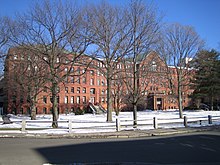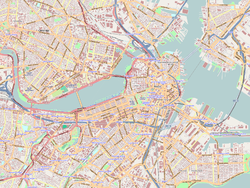This article relies largely or entirely on a
single source. (January 2011) |
 | |
| Established | 1998 (by merger of 3 earlier museums) |
|---|---|
| Location | 26 Oxford Street, Cambridge, Massachusetts 02138 |
| Coordinates | 42°22′42.29″N 71°6′55.99″W / 42.3784139°N 71.1155528°W |
| Collection size | 12,000 |
| Visitors | 210,000 (2013) |
| Owner | Harvard University |
| Public transit access | Harvard ( MBTA Red Line) |
| Website |
hmnh |
The Harvard Museum of Natural History (HMNH) is a natural history museum housed in the University Museum Building, located on the campus of Harvard University in Cambridge, Massachusetts. It features 16 galleries with 12,000 specimens drawn from the collections of the University's three natural history research museums: the Harvard University Herbaria, the Museum of Comparative Zoology, and the Harvard Mineralogical Museum. [1]
The museum is physically connected to the Peabody Museum of Archaeology and Ethnology at 26 Oxford Street. One admission grants visitors access to both museums. In 2012, Harvard formed a new consortium, the Harvard Museums of Science and Culture, whose members are the Harvard Museum of Natural History, the Harvard Museum of the Ancient Near East, the Peabody Museum, and the Collection of Historical Scientific Instruments. [2]
History
The Harvard Museum of Natural History was created in 1998 as the "public face" of three research museums—the Museum of Comparative Zoology, the Harvard Mineralogical and Geological Museum, and the Harvard University Herbaria. [3] Its exhibitions draw on Harvard University's natural history collections. Harvard's research faculty provides expertise and programs for members and the general public provide an exchange of information and ideas. With more than 210,000 visitors in 2013, the Harvard Museum of Natural History is the university's most-visited museum.[ citation needed]
Exhibits



In the museum's permanent galleries, visitors encounter the diversity of life on Earth, from dinosaurs to fossil invertebrates and reptiles, to large mammals, birds and fish, and the only mounted Kronosaurus. The mineralogical galleries present a systematic display of meteorites, minerals and gemstones. The galleries also house the historic Ware Collection of Blaschka Glass Models of Plants, [4] popularly known as the Glass Flowers, and the exhibit Sea Creatures in Glass, [5] displaying some of the Harvard Museum of Comparative Zoology's collection of the Blaschka models of marine invertebrates. In addition, a series of changing exhibitions bring focus to new research at the University.
Programs
The museum offers educational programs and has a partnership with Cambridge public schools; offers public lectures by Harvard biologists, international conservationists, and popular authors; and has a travel program where small groups are led by Harvard science faculty to biodiverse locations.
Operations
The museum is member-based, with over 3,200[ needs update] current members, primarily from the Boston metropolitan area. While the museum is affiliated with the Harvard's Faculty of Arts and Sciences and receives important support from the University, it derives most of its operating income from admissions, membership, gifts, and programmatic revenues.
References
- ^ Tucker, Aimee (31 March 2021). "Exploring the Harvard Museum of Natural History". New England Today.
- ^ Letteney, Timothy (2018-07-10). "Harvard Museums of Science & Culture fetes 300,000th visitor". Harvard Gazette. Retrieved 2022-06-26.
- ^ "The Museum". Harvard Museum of Natural History. Retrieved 2022-06-26.
- ^ "Glass Flowers: The Ware Collection of Blaschka Glass Models of Plants".
- ^ "Sea Creatures in Glass".
Further reading
- Pick, Nancy, & Sloan, Mark. (2004). The Rarest of the Rare: Stories Behind the Treasures at the Harvard Museum of Natural History. Harper. ISBN 978-0060537180
External links
- Harvard University museums
- Natural history museums in Massachusetts
- Museums in Cambridge, Massachusetts
- Harvard University buildings
- University museums in Massachusetts
- Museums established in 1998
- 1998 establishments in Massachusetts
- Association of Science-Technology Centers member institutions
- Buildings and structures completed in 1859
- National Register of Historic Places in Cambridge, Massachusetts
- University and college buildings on the National Register of Historic Places in Massachusetts
- Brick buildings and structures in the United States
- Renaissance Revival architecture in Massachusetts


